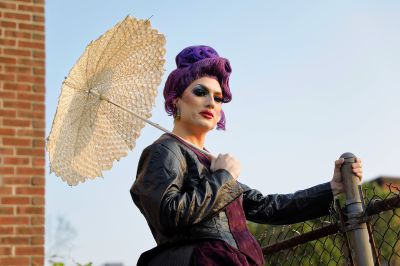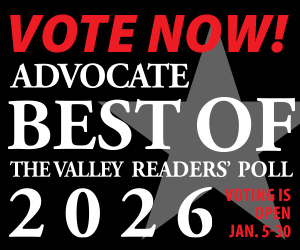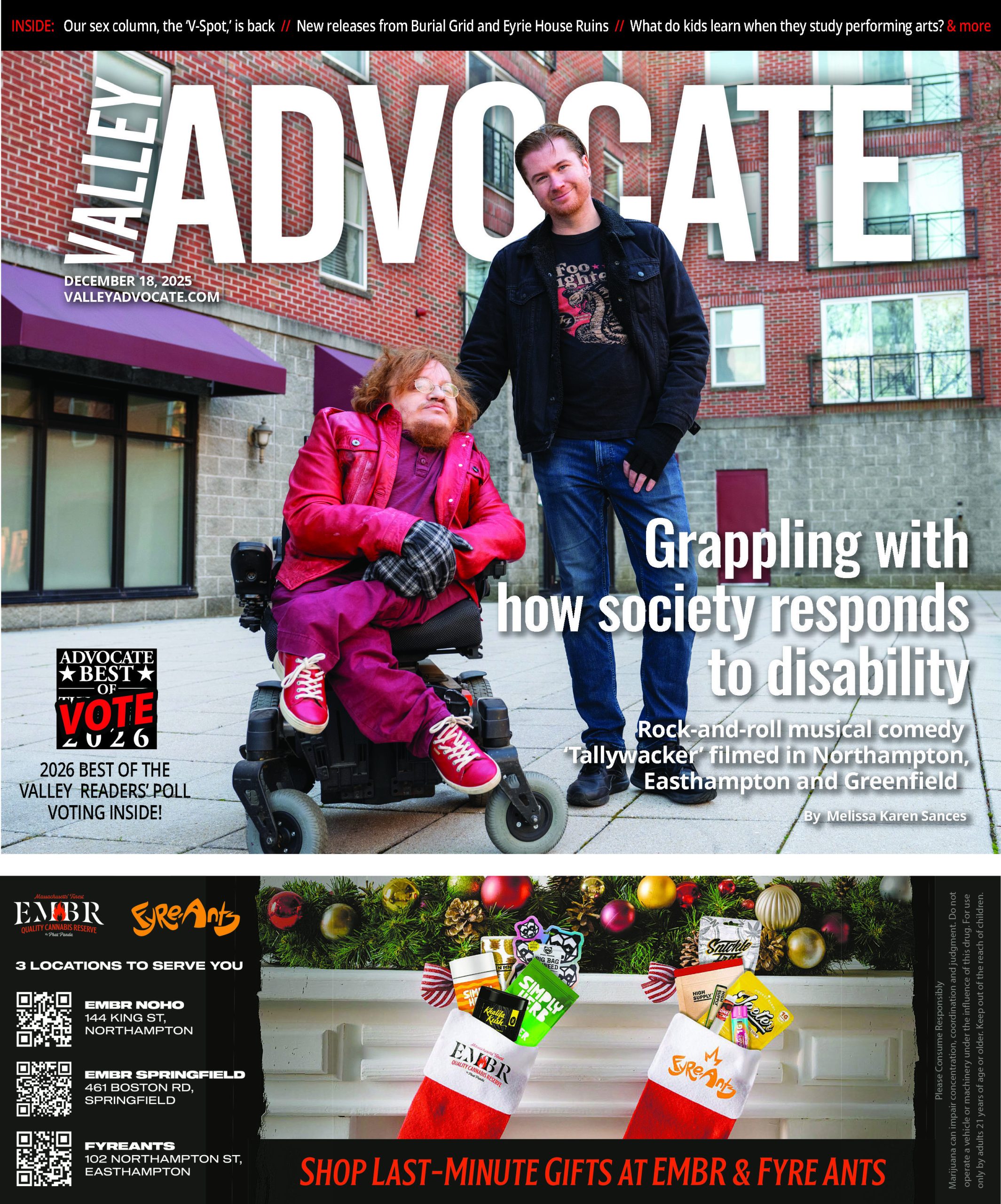By EMILY THURLOW
For the Advocate
Whether he’s sporting villainous Maleficent-style horns, channeling his inner witch dressed as Winifred Sanderson, twirling in a red-and-black polka-dot a-line dress or lounging around in a raglan T-shirt, Aaron Johnson is still, “just Aaron.”
Though the 33-year-old Greenfield man has been performing since he was about 12 years old, for the past decade he’s probably most recognized in western Massachusetts as “Boxxa Vine,” who he has affectionately described as the love child of actress Patti LuPone and a glue gun.
Johnson, a native of Colrain, has built a brand over the past decade under his drag stage name of Boxxa, having performed at countless venues throughout the state and beyond and holding several drag queen pageant titles to his name. Most recently, he’s ushered in the Franklin County Pride Parade as a co-marshall and has been headlining the Pride Celebration at Six Flags New England.
And as comfortable as he is now in a fierce pair of gold-metallic kitten heels and a custom-made curly bob wig, he didn’t always see the appeal of drag.
“I didn’t get it,” he said. “I didn’t understand the reason behind wanting to dress up as a female.”
As it turns out, he’s not alone.
32-year-old Marcel Jennings, also known as Mz. October May Lay, who holds numerous competition titles for performances as a drag queen and most recently co-marshalled the Pride parade with Johnson, admitted that drag was a bit unnerving to him at first.
“When I turned 21 and started going to clubs and was able to witness drag, I’ll be honest, it was a little scary to me. I just didn’t understand it,” he said. “But that changed once I learned the history of drag.”
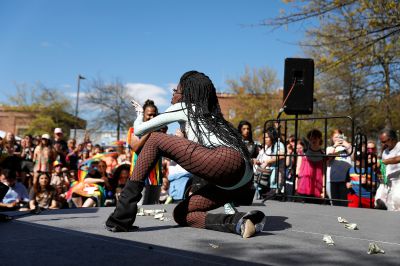
STAFF PHOTO/DAN LITTLE
Marcel Jennings performs as Mz. October May Lay during the Hampshire Pride festival in downtown Northampton on Saturday, May 6, 2023.
What is drag?
The National Center for Transgender Equality, a social justice organization, defines drag as a “type of entertainment where people dress up and perform, often in highly stylized ways.”
As a drag queen, performers may present themselves in exaggerated “feminine” ways as part of their performance, and a drag king may wear men’s clothing as part of more “masculine” performances. However, people of any gender can be either a drag queen or a drag king.
Although drag is at times lumped together with being transgender, drag is not a gender identity.
Drag often involves singing or lip-syncing, dancing and comedy as part of an overall performance.
The origins of drag have often been disputed as some contest that performances began in the 19th century with vaudeville shows or with the first self-proclaimed “queen of drag,” William Dorsey Swann, a formerly enslaved man who held private masquerades or drag balls at his home.
Others suggest that its roots may trace back to William Shakespeare when female roles were played by men or even encouraged in plays like “Twelfth Night,” where the character of Viola disguises herself as a young man named Cesario, or even farther back to ancient Greece and Rome.
The word “drag” has also been thought to have been used in theaters when describing the dresses men would wear to play female characters.
For Jennings, hearing the background of drag culture gave him a better appreciation of what is performance-based art.
Initially, Jennings, who lives in Hartford, Connecticut, and performs regularly in western Massachusetts, sought out the craft as a job, coming from a background as a competition dancer and teacher. Now a paraeducator with a public magnet school in Connecticut, Jennings says that drag offers him a way to express himself rather than a means of financial gains.
“I perform for people because I know that we’re all going through something as human beings and for some reason, drag and performance kind of takes that worry away for the moment,” he said.
He describes his persona, Mz. October, as an “experience.” He’s been told that she provides a “light where it’s needed” and she doesn’t have a care in the world.
“She knows how to make everyone feel welcome, and even me, Marcel, I can’t do that. But for some reason, when I’m in drag as Mz. October, I can do that to a room or a crowd,” he said. “Sometimes it’s hard to believe… but when I put on my wigs and I put on my costumes, I do what I feel like I need to do.”
Outside of drag, Jennings likes to watch YouTube videos at his house or make a music mix and keep to himself. But with drag, he’s a social butterfly. He finds that Mz. October teaches him how to be more social.
And while there are some differences between his life out of drag and drag persona, Jennings said there is some overlap in how he likes to be identified: “Beyonce.”
The rise of drag
Drag culture has been heavily linked to the LGBTQ+ community and depicted in popular culture throughout the 20th century, including in films like “To Wong Foo, Thanks for Everything! Julie Newmar,” starring Wesley Snipes, John Leguizamo, and the late Patrick Swayze, and “The Birdcage” with Nathan Lane and the late Robin Williams.
In recent years, drag culture has been catapulted into the mainstream limelight courtesy of RuPaul Charles. In 2009, his show, “RuPaul’s Drag Race” debuted and has been a continuous sensation. Since then, Charles, the producer and host of the show, has nabbed 12 Emmys and has become the most-awarded Black artist in the history of the annual outstanding achievement in television awards.
Locally, RuPaul’s hit television show has also had a tremendous impact.
After watching season four where (spoiler alert) drag contestant Sharon Needles won, Johnson says drag suddenly clicked for him.
“I thought she was going to go home first, but then they did that post-apocalyptic, make-your-own-outfit challenge and I was like, ‘Oh. This is like horror movies.’ Sharon came out looking like a zombie… I thought, ‘she’s gonna win this season,’ and suddenly, I got drag,” he said. “It’s literally theater.”
Though he had an extensive theater background, having performed as an entertainer for several years in Florida for Disney and Universal, Johnson wanted to build up his future craft and taught himself to sew and started making his own costumes.
Similarly, Andrew Curran of Northampton tapped into the art form after watching drag performers Trixie Mattel and Katya, past winners of RuPaul’s show, on YouTube. From there, he found himself hooked to “Drag Race,” which inspired him to start making videos of his own. The videos would consist of lip-syncing to songs and using his performances to raise money for particular causes, such as the Black trans community.
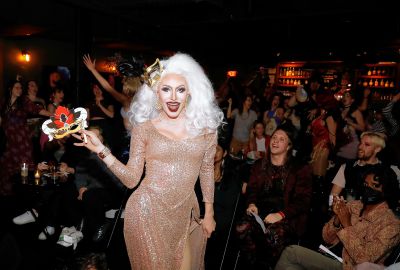
STAFF PHOTO/DAN LITTLE
Magnolia Masquerade aka Andrew Curran performs during a drag production at the Drake in Amherst, Thursday, June 8, 2023.
After finishing a degree in creative writing at Holyoke Community College and a bachelor’s in English from the University of Massachusetts Amherst, he took his world of storytelling to drag.
Now 24 years old, Curran describes his drag persona, Magnolia Masquerade, as being an immortal who is roughly 350 years old – though the exact age changes from time to time – and is a poltergeist who possesses his body. She’s also a Southern belle from New Orleans. The name Magnolia is also a nod to the state of Louisiana, whose bloom is among the state’s symbols.
“She is Victorian, but also very disco, and she is a misandrist, she hates men. But she also really loves men – sometimes she just hates how much she loves them,” said Curran. “It’s like a spooky decadence.”
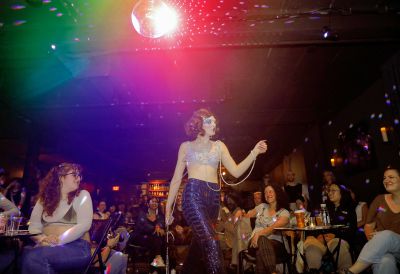
STAFF PHOTO/DAN LITTLE
Misandrie works the crowd during a drag production by Andrew Curran at the Drake in Amherst, Thursday, June 8, 2023.
Correcting misconceptions
Though drag culture continues to evolve, there’s a lot of stigma associated with the art form. Even widely-recognized dictionaries describe drag queens as only being cisgender, homosexual men dressing as women. However, Faolain “Fay” Bobersky of Easthampton will tell you firsthand that that definition is incorrect.
Bobersky, who is a 27-year-old woman, regularly performs as a drag queen alongside Curran.
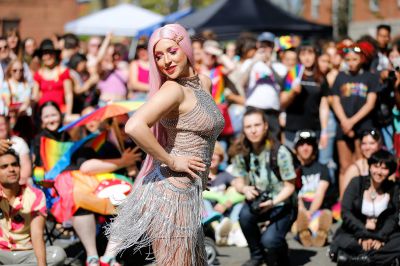
Faolain Bobersky performs as Dr. Pepper, MD, during the Hampshire Pride festival in downtown Northampton on Saturday, May 6, 2023.
“She’s a lady assigned at birth… you don’t always think about women being drag queens, but Fay does,” said Curran. “Her drag looks different from mine, but she’s a drag queen. She heightens her femininity in the same way that I heighten mine, except mine takes multiple more hours.”
Bobersky began performing in drag in college after she saw a poster seeking people to audition for a drag show. Bobersky also noted that she has been immersed in queer culture since her childhood as she was an in vitro fertilization baby with two lesbian moms and two gay dads.
And similar to Johnson and Curran, Bobersky also grew an immediate fondness for “RuPaul’s Drag Race.”
“I’ve always loved drag. I’ve always loved drag queens and I thought it would be a great way for me to learn more about that in a supporting role… and dip my toes into the water,” she said.
But as it turns out, she did more than dip her toes in the water.
As her drag persona, Dr. Pepper, MD, Bobersky said she feels safe to be super-feminine and girly, more so than outside of drag. She said she’s often felt concerned it would appear as though she were inviting unwanted attention.
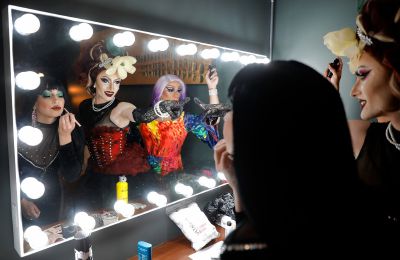
STAFF PHOTO/DAN LITTLE
Performers Dr. Pepper, MD, Magnolia Masquerade and Ruby Monroe put on the finishing touches in the mirror before the start of the drag production at the Drake in Amherst, Thursday, June 8, 2023.
“For me, drag and queer performance spaces are like the perfect place for me to live out these super hyper-feminine, over the top, glamorous fantasies from all these stars and people that I’ve admired,” she said. “I think drag is a radical way for queer people to take up space at the same time that they’re celebrating the fact that they are existing and taking up space. I think so much about being queer, in public, especially being queer on stage and asking not only to be seen, but to be celebrated, is really at the core of what drag is and has always been.”
Another common misconception from people unfamiliar with the drag community is that drag is “silly and clownish” in an unproductive way. In several southern states, drag has been classified as an “adult cabaret” performance that’s hypersexual and unhinged, said Bobersky.
As Boxxa, Johnson gets to be a star. As Mz. October, Jennings feels like he can help people. As Magnolia, Curran is able to tap into performative storytelling. And as Dr. Pepper, Bobersky is able to celebrate queer joy through expression.
Above all, the biggest myth of all is that drag queens are dangerous, said Johnson.
Since the beginning of the year, more than 30 bills have been filed in states like Arizona, Montana, Tennessee, Texas and West Virginia that specifically target drag performances. States like Florida have proposed felony charges and taking away parental rights if minors attend a drag show.
“It’s un-American,” he said. “You can’t tell me that I have the pursuit of life, liberty and the American dream, but then say that my dream is unlawful. Most of these events are ticketed events, and even if they’re not, you can choose to not attend… It’s absolutely un-American to say that I can’t do something with my life.”
Though Johnson hasn’t experienced familial backlash personally, he feels that the real fear behind the extensive targeted legislation stems from individuals being scared their children will identify with the community and identify with seeing themselves represented.
“The amount of trans and queer kids that kill themselves because they live in a world where their parents won’t accept them in any way is daunting,” he said. “If you want to love and nurture someone who you bring into the world, let them be whoever they end up being.”
Editor’s Note: “Shantay, You Stay!” is a phrase coined by RuPaul Charles on the show “RuPaul’s Drag Race.”


